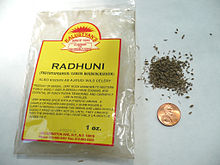
Dill is an annual herb in the celery family Apiaceae. It is native to North Africa, Iran, and the Arabian Peninsula; it is grown widely in Eurasia, where its leaves and seeds are used as a herb or spice for flavouring food.
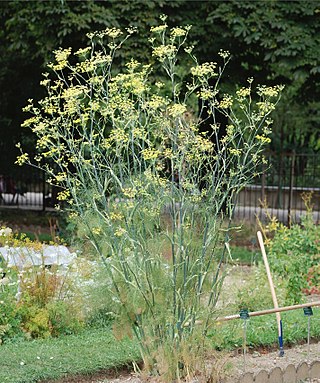
Fennel is a flowering plant species in the carrot family. It is a hardy, perennial herb with yellow flowers and feathery leaves. It is indigenous to the shores of the Mediterranean but has become widely naturalized in many parts of the world, especially on dry soils near the sea coast and on riverbanks.

Garam masala is a blend of ground spices originating from South Asia. It is common in Indian, Pakistani, Nepalese, Bangladeshi, Sri Lankan and Caribbean cuisines. It is used alone or with other seasonings. The specific fixings differ by district, but it regularly incorporates a blend of flavors like cardamom, cinnamon, cumin, cloves and peppercorns. Garam masala can be found in a wide range of dishes, including marinades, pickles, stews, and curries.

Ajwain or ajowan —also known as ajowan caraway, వాము ,omam , thymol seeds, bishop's weed, or carom—is an annual herb in the family Apiaceae. Both the leaves and the seed‑like fruit of the plant are consumed by humans. The name "bishop's weed" also is a common name for other plants. The "seed" is often confused with lovage seed.

Momordica charantia is a tropical and subtropical vine of the family Cucurbitaceae, widely grown in Asia, Africa, and the Caribbean for its edible fruit. Its many varieties differ substantially in the shape and bitterness of the fruit.

Jaggery is a traditional non-centrifugal cane sugar consumed in the Indian subcontinent, Southeast Asia, North America, Central America, Brazil and Africa. It is a concentrated product of cane juice and often date or palm sap without separation of the molasses and crystals, and can vary from golden brown to dark brown in colour. It contains up to 50% sucrose, up to 20% invert sugars, and up to 20% moisture, with the remainder made up of other insoluble matter, such as wood ash, proteins, and bagasse fibres. Jaggery is very similar to muscovado, an important sweetener in Portuguese, British and French cuisine. The Kenyan Sukari ngutu/nguru has no fibre; it is dark and is made from sugarcane and also sometimes extracted from palm tree.
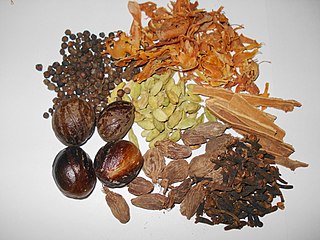
Spice mixes are blended spices or herbs. When a certain combination of herbs or spices is called for in a recipe, it is convenient to blend these ingredients beforehand. Blends such as chili powder, curry powder, herbes de Provence, garlic salt, and other seasoned salts are traditionally sold pre-made by grocers, and sometimes baking blends such as pumpkin pie spice are also available. These spice mixes are also easily made by the home cook for later use.

Biryani is a mixed rice dish, mainly popular in South Asia. It is made with rice, some type of meat and spices. To cater to vegetarians, in some cases, it is prepared by substituting vegetables or paneer for the meat. Sometimes eggs or potatoes are also added.

Pānch Phoron, Pānch Phodan or Pāncha Phutaṇa is a whole spice blend, originating from Eastern part of India, India, used as a prominent ingredient for Odia, Bengali and other Eastern Indian pickles and other savoury and sweet dishes. It is also used in the other cuisines such as those of Bangladesh and Northeastern India, especially in the cuisines of Bhojpur, Mithila, Odisha, Assam, Bengal and Nepal. The name literally means "five spices".

Berbere is a spice mixture whose constituent elements usually include chili peppers, coriander, garlic, ginger, Ethiopian holy basil (besobela) seeds, korarima, rue, ajwain or radhuni, nigella, and fenugreek. It is a key ingredient in the cuisines of Ethiopia and Eritrea. Berbere also refers to chili pepper itself.

Elwendia persica is a plant species in the family Apiaceae. It is related to cumin and sometimes called black cumin, blackseed, or black caraway, and has a smoky, earthy taste. It is often confused with Nigella sativa, by which it is often substituted in cooking.
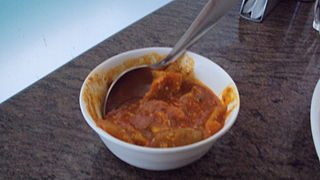
South Asian pickle is a pickled food made from a variety of vegetables, meats and fruits preserved in brine, vinegar, edible oils, and various South Asian spices. The pickles are popular across South Asia, with many regional variants, natively known as lonache, avalehikā, uppinakaayi, khatai, pachadi or noncha, achaar, athāṇu or athāṇo or athāna, khaṭāī or khaṭāin, sandhan or sendhan or sāṇdhāṇo, kasundi, or urugaai.

Alpinia galanga, a plant in the ginger family, bears a rhizome used largely as an herb in Unani medicine and as a spice in Arab cuisine and Southeast Asian cookery. It is one of four plants known as "galangal". Its common names include greater galangal, lengkuas, and blue ginger.
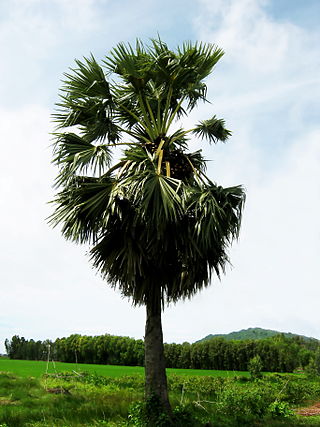
Borassus flabellifer, commonly known as doub palm, palmyra palm, tala or tal palm, toddy palm, lontar palm, wine palm, or ice apple, is a fan palm native to South Asia and Southeast Asia. It is reportedly naturalized in Socotra.
The following outline is provided as an overview of and topical guide to herbs and spices:
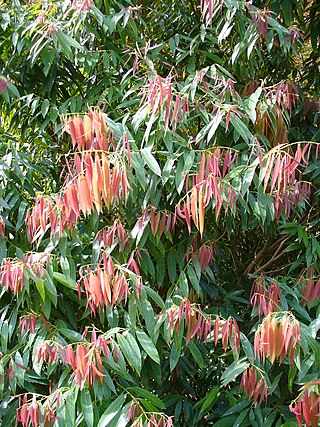
Nagkesar oil is extracted from seeds of the nagkesar tree. It belongs to the Calophyllaceae family. It is an East Indian evergreen tree and is often planted as an ornamental for its fragrant white flowers that yield a perfume. It is the source of hardwood used for railroad ties. It is Sri Lanka's national tree.
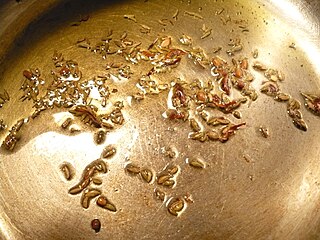
Tempering is a cooking technique used in India, Bangladesh, Nepal, Pakistan, and Sri Lanka in which whole spices are cooked briefly in oil or ghee to liberate essential oils from cells and thus enhance their flavours, before being poured, together with the oil, into a dish. Tempering is also practiced by dry-roasting whole spices in a pan before grinding the spices. Tempering is typically done at the beginning of cooking, before adding the other ingredients for a curry or similar dish, or it may be added to a dish at the end of cooking, just before serving.

Kasundi is the Bengali variety of mustard sauce or relish. It has the pungent paste of fermented mustard seeds, spices and sometimes dried mangoes, dried Indian plum and olives. Kasundi is popular as a dipping sauce in Bengali cuisine.
